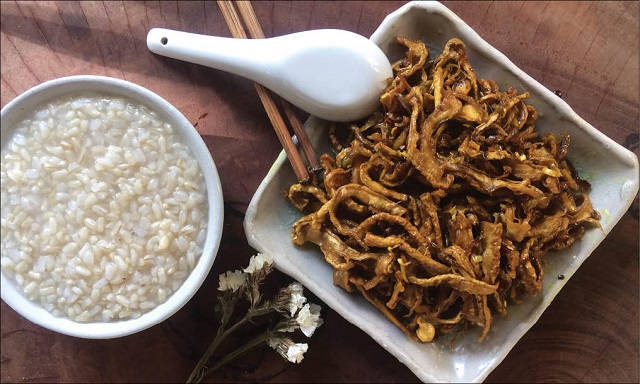
Besides rice, simmered dried daikon radish with galangal and lemongrass goes perfectly well with porridge.
Mom’s pantry for the rainy season is always full of mysteries, from a pot of fermented garden eggs kept under the paddy seed hamper to a pack of dried bamboo shoots hanged high above and another neatly wrapped bunch of daikon radishes. And there were mung beans, peanuts, dried chili, corn, …
With these provisions, we simply feel enough even in the depth of the most difficult season. The mysteries unfold with completely unexpected dishes beyond my wildest imagination.
Every sunny season returns vividly in my mind when herring and anchovy become seasonally plentiful, and mom bought some to make fermented fish paste. Then available green papaya or garden eggs are sundried to later marinate with fish. By winter, we’ll have had flavorful fermented garden eggs to survive the cold season.
And the young bamboo shoots that grow around the house can be freshly picked and cooked. The bigger and older ones are thinly sliced to be boiled and dried, and for rainy and cold days, braised with pounded roasted peanuts. Such winter specialties must include the tasty simmered dried daikon radish with galangal and lemongrass – an exclusive dish improvised by mom.
I always take pride in mom’s improvisation. She turns an ordinary banana blossom into "vegan chicken,” and slices of dried bamboo shoots into one-of-a-kind “beef stew". And of course, her simmered dried daikon radish with galangal and lemongrass delights us just the same.
When I was little, my family grew daikon radish after every Tet and harvested it by the coming summer. A small part of the yield was used right away in stir-fries, simmers, and broth stews. The rest was sundried.
Dried daikon radish is staple in many special dishes. It can be wet simmered in soy sauce or soaked and softened to stir fry with crispy pork fat. Yet to my mind, the most impressive and original dish from this root veggie is simmered dried daikon radish with galangal and lemongrass. I thus sometimes grab a bunch of daikon from the market to sundry and relive the taste of the old days.
Galangal and lemongrass bring out the most distinctive flavor of this dish besides many other herbs and spices such as ginger, turmeric, garlic, chili, and especially pineapple.
It is inexplicable why mom can combine so many ingredients, but the dish is truly out of this world. All of the ingredients are available around the house: from a just-ripe pineapple to galangal and lemongrass found on the field edge, as well as ginger and garlic always present in the kitchen.
I’ve got the chance to see how mom meticulously prepares this dish. First, dried daikon radish is soaked and softened in water, then squeezed dry. Galangal and ginger are shredded, lemongrass sliced; garlic, chili and turmeric finely pounded; and pineapple peeled, thinly sliced, then juiced. Sweeter pineapple makes a better dish. Start cooking when everything is ready.
First, mom uses some lard to pan-fry turmeric and lemongrass. When lemongrass becomes aromatic, and turmeric starts to shrink, add the remaining herbs and spices all in. Continue pan-frying to create more fragrance.
Add the pineapple flesh and daikon radish to the mixture and season it with salt and fish sauce. Later, the pineapple juice is poured over to add natural sweetness to the dish, creating a healthy and fresh specialty from all-natural ingredients.
In cooking, the sense of touch and sight is vital. As it’s hard to decide on the exact amount of salt, pepper, or cooking heat, only focus and devotion can truly bring a perfect dish. Mom has never explicitly said the dish needs 2 tbsp of salt, 3 tbsp of fish sauce, or how many ml of oil. Everything comes naturally and harmoniously in what mom cooks – a distinctively mom-made signature behind each dish that we can always recognize the flavor.
Simmered dried daikon radish with galangal and lemongrass has the most extensive ingredient list that goes from the dry to the rainy season. That’s to say some dishes cannot be made available spontaneously but need elaborate preparation from the early dew of spring to the sunshine of summer then winter for their wondrous taste.
Story and photo: YEN THUONG
